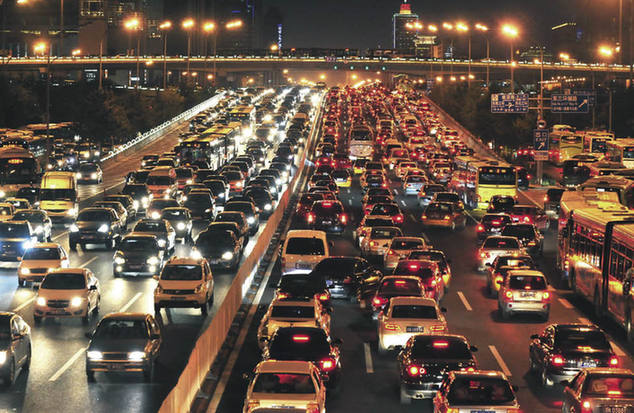| Jam Today, Jam Tomorrow?
By staff reporter GONG HAN
|
 |
|
Whiling away hours sitting in traffic jams is the most common daily relaxation offered by China's big cities. |
YOU can buy anything in New York, except for a smooth ride in and out of the city."
This common saying could equally apply to Beijing. 2010 seemed to produce one nightmare traffic jam after another: at the beginning of the year, snowfall resulted in gridlock on over 90 roads; in August, a 100-km-long jam glued up the Beijing-bound lanes of the Beijing-Tibet Expressway for more than 20 days – an event described as "epic" by The New York Times; on September 17, a rain brought traffic to a standstill on a record 140 roads during the evening rush hour.
On December 23, 2010, the municipal government of Beijing took another measure to put a brake on car sales: the issuing of license plates is capped at 240,000 a year, and car buyers have to draw lots to get one. In the previous year alone 800,000 additional cars hit the city's roads.
Ironically, on the day the new policy came into effect, Peking University Professor Feng Changchun couldn't make it to the TV studio where he had been invited by CCTV to discuss the new regulation. He had to phone in his opinion from a traffic jam on the West Third Ring Road.
Scenes like this occur daily. Ms. Chen lives in Tongzhou, a suburb district with a large population of downtown office workers. She once spent three hours driving 30 kilometers and needs to leave home at six a.m. to make the office on time.
Jams are spreading into China's second- and third-tier cities too, at a speed described as "explosive" by Yang Xinmiao, deputy director of the Institute of Transportation Engineering, Tsinghua University.
Traffic congestion is becoming a "city malady" afflicting every urban resident. According to the Ministry of Public Security's Traffic Administrative Bureau, China has 199 million motor vehicles, over 85 million of which are cars. Two-thirds of China's 667 cities experience rush-hour congestion. There's no escaping the problem, even for those who can quit big city life.
Li Guoqing of the Institute for Urban and Environmental Studies, Chinese Academy of Social Sciences (CASS), wrote in an article that the popularization of cars occurs when the per capita GDP reaches US $3,000 a year. At this stage, people's incomes are increasing at a remarkable rate and private cars are supplanting refrigerators, TV sets and washing machines as the new consumption item. The number of motor vehicles in Beijing was two million in August 2003, but it took only three years and nine months for that number to reach three million, and just two years and seven months to reach four million. He compares this with Tokyo, where going from two to three million took 10 years, and another 12 years to reach four million. By September 2010, the number of vehicles in Beijing exceeded 4.5 million. The extra cars in 2010 alone overtook the total car population of Hong Kong.
China's urbanization provides the backdrop to this phenomenon. Greater employment prospects in urban areas cause people to flock to cities and exacerbate the traffic situation. As of the end of 2009, the number of people actually living in Beijing was 19.72 million, already smashing the capital's 2020 maximum target of 18 million. There is plenty of potential for the congestion problem to spread. According to CASS, as of 2009, the rate of urbanization was 46.6 percent which is lower than the world average .
Many metropolises in the world have had some success in solving or at least mitigating urban congestion, so there is hope. However, the situation here is more complicated: the urban-rural economic divide provides an unstoppable flow of people into cities; the confluence of government departments and businesses at the center of a city drives up real estate prices, sending local residents further into the cheaper suburbs and thus creating the huge legions commuting between their offices and homes everyday; the vast car fleets owned by government offices are prone to overuse; transportation planning and management are outdated; and poor driving habits make a bad situation even worse.
The official website for Beijing's car plate lottery is "bjhjyd." These are the initials of the Chinese phrase for "Beijing is solving congestion." But they could also represent "Beijing congestion continues," as has been satirically pointed out.
Can Beijing and other Chinese cities get out of the jam? The answer is probably a negative one. How long will this go on? What's our vision for urban development and who does this development serve? These questions test the work efficiency and management expertise of urban planning and transportation departments, and hover over every city-dweller too.
| 